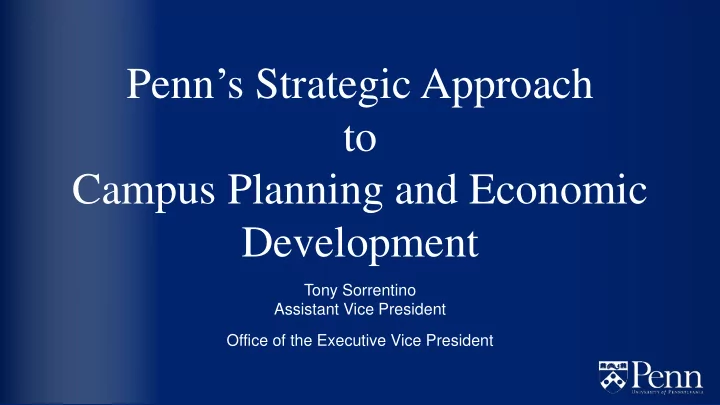

Penn ’ s Strategic Approach to Campus Planning and Economic Development Tony Sorrentino Assistant Vice President Office of the Executive Vice President
Founded 1740 4 th & Arch St 1829 Moved to 9 th and Chestnut Last move 1872 Penn moves to Suburban West Phila – 1871
Campus Growth: 1872-present
Era of Urban Renewal and Penn Students Vote with their feet Campus Character Urban Renewal Blight Increase in Crime Science Center
Land Redevelopment and its Impacts Federal Government: Urban Renewal Act 1960s: Protests Against Campus Expansion and Urban Renewal • Relocation of businesses • Demolition of structures • Relocation of people • Use of eminent domain to take private property for development projects.
Penn Presidents Faced a Growing University, Limited Land, Urban Decline Gaylord P. Martin Harnwell Meyerson President as Planner 1953 - 1970 President as Builder 1970 - 1981
Physical Alienation from the Community
Period of Decline in University City
University City by 1990: Fight or Flight? A Strategic Approach to Local Engagement: High crime rates against persons and Urban property Planning Property Retail abandonment and Housing Development disinvestment Safety & Security Increasing poverty rates Public Economic Education Development Isolate, Flight, or Fight?
Penn ’ s Presidents and the Evolution of Local Engagement Sheldon Hackney 1981-1993 Netter Center for Community Partnerships: Academic Based Community Service Local Civic Engagement Supporting Public Education Judith Rodin 1994 -2004 West Philadelphia Initiatives: Safety and Security Housing and Homeownership Retail and Commercial Development Public Education Economic Inclusion Amy Gutmann 2004-present The Penn Compact: • Inclusion • Innovation • Impact 10
Neighborhood Initiatives Results Crime Down 50% In Ten Years $1 Billion 1083 Total spend Safety Home Locally Purchases Since 1986 Since 1998 Economic Housing Inclusion WPI 400,000 20 year Sq. Ft. $7 Million New Retail Investment Real Estate Since 1996 Education Development K-8 public school
Lessons Learned • Nature of universities to grow • Growth can create tensions particularly in an urban environment where land is more scarce • Working with local community in a comprehensive manner can lead to real changes • Land control very important • Master planning crucial to the campus development • Role for third party developers to work effectively with universities to advance the mission
Recommend
More recommend